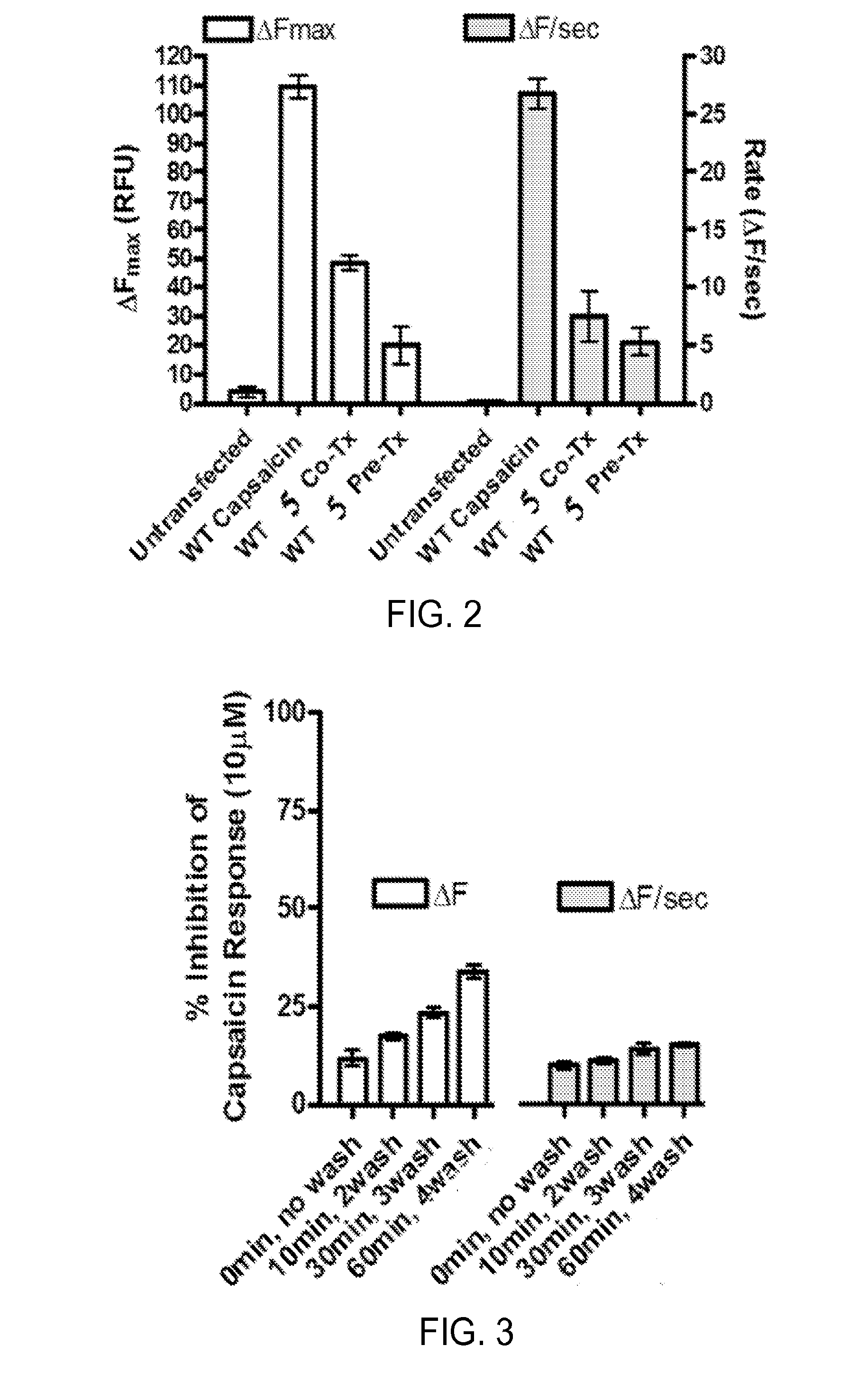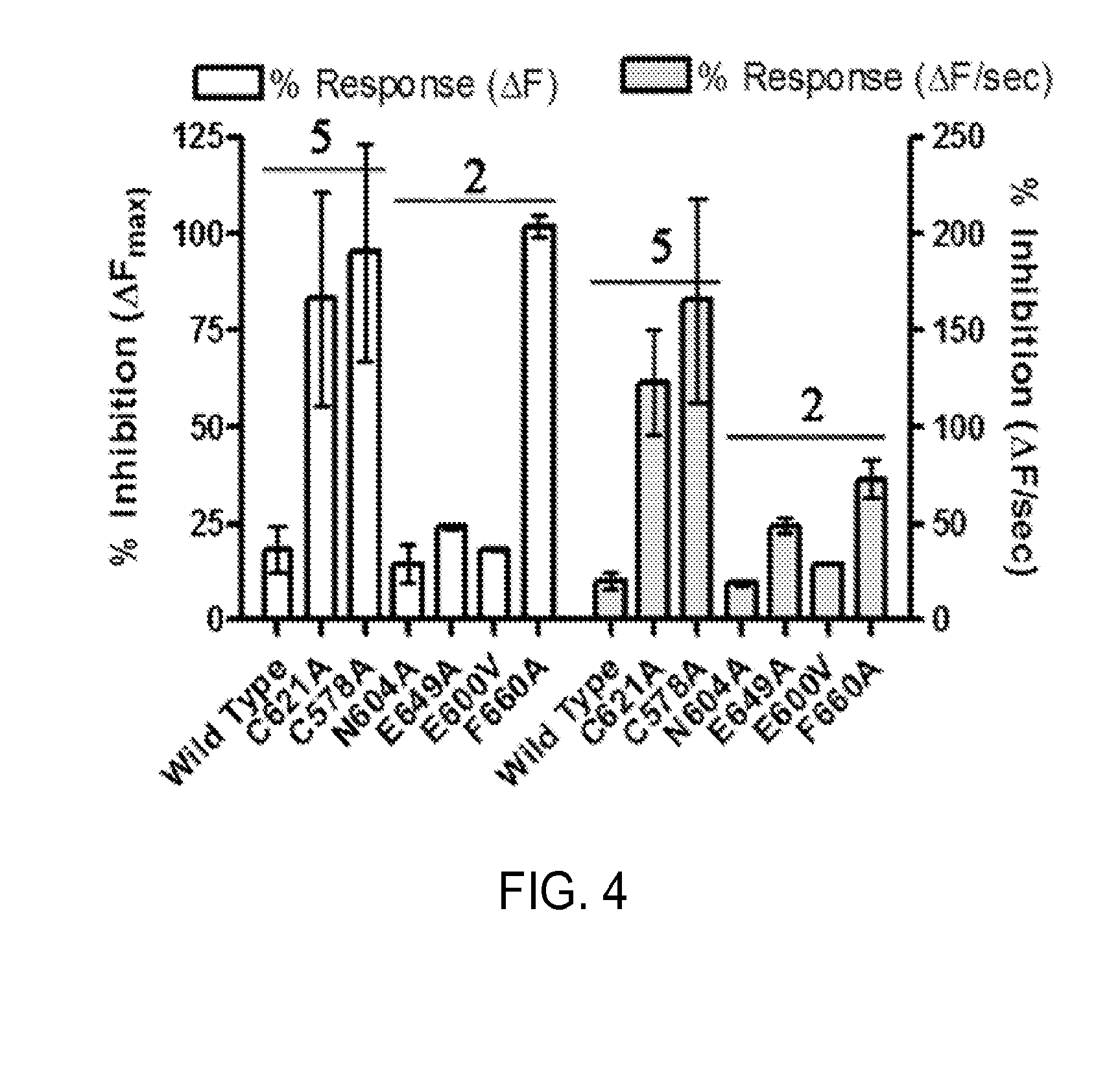Antagonists of trpv1 receptor
a technology of trpv1 receptor and antagonist, which is applied in the direction of peptides, drug compositions, peptides, etc., can solve the problem of pain desensitization in the longer term
- Summary
- Abstract
- Description
- Claims
- Application Information
AI Technical Summary
Benefits of technology
Problems solved by technology
Method used
Image
Examples
example 1
Data Collection
[0063]UV spectra were obtained using a Perkin-Elmer Lambda2 UV / vis spectrometer. IR spectra were recorded on a JASCO FT / IR-420 spectrometer. NMR data were collected using either a Varian NOVA 500 (1H 500 MHz, 13C 125 MHz) NMR spectrometer with a 3 mm Nalorac MDBG probe or a Varian INOVA 600 (1H 600 MHz, 13C 150 MHz) NMR spectrometer equipped with a 5 mm 1H[13C, 15N] triple resonance cold probe with a z-axis gradient and utilized residual solvent signals for referencing. High-resolution mass spectra (HRMS) were obtained using a Bruker (Billerica, Mass.) APEXII FTICR mass spectrometer equipped with an actively shielded 9.4 T superconducting magnet (Magnex Scientific Ltd., UK), an external Bruker APOLLO ESI source, and a Synrad 50W CO2 CW laser. All compounds were assessed to be >99% pure by HPLC with DAD and MS detectors.
example 2
Fermentation and Extraction
[0064]Strains CN48 and CT3a were cultivated from dissected tissues of the mollusks Chicoreus nobilis and Conus tribblei, respectively, and each were individually grown at 30° C. with shaking at 200 rpm in a 10 L fermentor containing 10 L of ISP2 medium (0.2% yeast extract, 1% malt extract, 0.2% glucose, 2% NaCl). After 8 days, the broth was centrifuged and the supernatant was extracted with HP-20 resin for 4 hours. The resin was filtered through cheesecloth, washed with water to remove salts, and eluted with MeOH to yield the crude extract.
example 3
Purification
[0065]The crude extract (650 mg) from Example 2 of CN48 was separated into 5 fractions (Fr1-Fr5) on a C18 column using gradient elution of MeOH in H2O (50%, 60%, 70%, 80%, 100%). Fr4 eluting in 80% MeOH was further purified by C18 HPLC using 85% MeOH in H2O to obtain compound 4 (100.0 mg) and compound 6 (4.0 mg), and two further fractions Fr4-3 and Fr4-4. Fr4-3 was further purified by C18 HPLC using 37% CH3CN in H2O with 0.1% TFA to obtain compound 5 (2.0 mg), compound 7 (1.0 mg), and compound 8 (1.2 mg). Fr4-4 was further purified by C18 HPLC using 45% CH3CN in H2O with 0.1% TFA to obtain compound 1 (150.0 mg). Fraction Fr5 was further purified by C18 HPLC using 55% CH3CN in H2O with 0.1% TFA to obtain compound 2 (1.0 mg).
[0066]The crude extract (350 mg) from Example 2 of CT3a was separated into 5 fractions (Fr1-Fr5) on a C18 column using gradient elution of MeOH in H2O (20%, 40%, 60%, 70%, 80%). Fr4 eluting in 70% MeOH was further purified by C18 HPLC using 39% CH3CN i...
PUM
| Property | Measurement | Unit |
|---|---|---|
| Molar density | aaaaa | aaaaa |
| Concentration | aaaaa | aaaaa |
Abstract
Description
Claims
Application Information
 Login to View More
Login to View More - R&D
- Intellectual Property
- Life Sciences
- Materials
- Tech Scout
- Unparalleled Data Quality
- Higher Quality Content
- 60% Fewer Hallucinations
Browse by: Latest US Patents, China's latest patents, Technical Efficacy Thesaurus, Application Domain, Technology Topic, Popular Technical Reports.
© 2025 PatSnap. All rights reserved.Legal|Privacy policy|Modern Slavery Act Transparency Statement|Sitemap|About US| Contact US: help@patsnap.com



